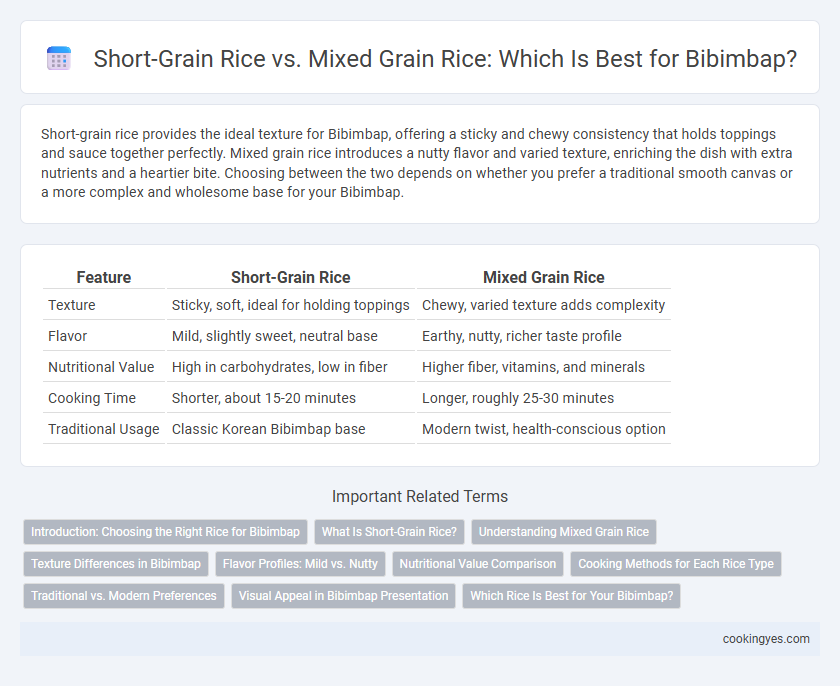Short-grain rice provides the ideal texture for Bibimbap, offering a sticky and chewy consistency that holds toppings and sauce together perfectly. Mixed grain rice introduces a nutty flavor and varied texture, enriching the dish with extra nutrients and a heartier bite. Choosing between the two depends on whether you prefer a traditional smooth canvas or a more complex and wholesome base for your Bibimbap.
Table of Comparison
| Feature | Short-Grain Rice | Mixed Grain Rice |
|---|---|---|
| Texture | Sticky, soft, ideal for holding toppings | Chewy, varied texture adds complexity |
| Flavor | Mild, slightly sweet, neutral base | Earthy, nutty, richer taste profile |
| Nutritional Value | High in carbohydrates, low in fiber | Higher fiber, vitamins, and minerals |
| Cooking Time | Shorter, about 15-20 minutes | Longer, roughly 25-30 minutes |
| Traditional Usage | Classic Korean Bibimbap base | Modern twist, health-conscious option |
Introduction: Choosing the Right Rice for Bibimbap
Short-grain rice provides the ideal chewy texture and sticky consistency essential for Bibimbap, allowing it to hold together well under mixed toppings. Mixed grain rice, often incorporating barley, black rice, or millet, offers added nutritional benefits and a nuttier flavor profile that enhances the overall dish. Selecting the right rice base directly influences the balance of texture, taste, and healthfulness in traditional Korean Bibimbap.
What Is Short-Grain Rice?
Short-grain rice, known for its plump, sticky texture, is the preferred base in traditional Bibimbap due to its ability to hold ingredients together and absorb sauces evenly. This rice variety, often polished white or slightly translucent, contrasts with mixed grain rice, which includes combinations like barley, millet, or black rice, offering a nuttier flavor and chewier texture but less stickiness. Choosing short-grain rice enhances the authentic mouthfeel and cohesive bite essential to classic Korean Bibimbap dishes.
Understanding Mixed Grain Rice
Mixed grain rice combines short-grain white rice with various grains like barley, millet, and black rice, enhancing the nutritional profile of Bibimbap by increasing fiber, vitamins, and minerals. This blend offers a chewier texture and nuttier flavor compared to the softer, stickier nature of traditional short-grain rice. Understanding mixed grain rice allows for a healthier, more textured base that complements the diverse ingredients and bold flavors of classic Bibimbap.
Texture Differences in Bibimbap
Short-grain rice provides a sticky, chewy texture that helps bind the ingredients of bibimbap together, enhancing the overall eating experience with its moist consistency. Mixed grain rice, containing varieties like barley and black rice, offers a nuttier flavor and a firmer, slightly crunchy texture that adds complexity and contrast to the dish. This textural variation influences the mouthfeel of bibimbap, with short-grain rice creating a smooth base and mixed grain rice delivering a more robust bite.
Flavor Profiles: Mild vs. Nutty
Short-grain rice provides a mild, slightly sweet flavor and sticky texture, creating a perfect base for Bibimbap's vibrant toppings. Mixed grain rice introduces a nutty, earthy flavor with a firmer bite, adding depth and complexity to each bite. Selecting between these rice options influences the overall taste experience, balancing traditional softness with enhanced texture and aroma.
Nutritional Value Comparison
Short-grain rice, traditionally used in Bibimbap, offers a sticky texture ideal for mixing but contains fewer nutrients compared to mixed grain rice, which blends brown rice, barley, and millet. Mixed grain rice provides higher fiber content, essential vitamins like B-complex, and minerals such as magnesium and iron, enhancing the dish's overall nutritional profile. Incorporating mixed grains improves antioxidant levels and supports digestive health, making it a superior choice for a nutrient-dense Bibimbap base.
Cooking Methods for Each Rice Type
Short-grain rice, favored for Bibimbap, requires thorough washing and soaking to achieve its characteristic sticky texture, ideal for mixing with other ingredients. Mixed grain rice, containing varieties like barley or black rice, often demands longer soaking times and adjusted water ratios to ensure even cooking and a balanced chewy consistency. Cooking short-grain rice typically involves a shorter simmer and resting period, whereas mixed grain rice benefits from slow simmering and extended steaming to fully soften the diverse grains.
Traditional vs. Modern Preferences
Short-grain rice remains the traditional base for Bibimbap, prized for its sticky texture that perfectly holds toppings together, enhancing the authentic Korean dining experience. Modern variations often incorporate mixed grain rice, combining white rice with barley, black rice, or millet to increase nutritional value and introduce varied textures. This shift reflects evolving health trends while respecting Bibimbap's cultural heritage by balancing flavor, texture, and wellness.
Visual Appeal in Bibimbap Presentation
Short-grain rice creates a sticky, glossy base that enhances the vibrant colors of Bibimbap ingredients, making the dish visually cohesive and appealing. Mixed grain rice introduces varied textures and natural hues, such as browns and purples, adding depth and contrast to the presentation. Using short-grain rice emphasizes uniformity and brightness, while mixed grain rice offers a rustic and nutrient-rich appearance that attracts attention on the plate.
Which Rice Is Best for Your Bibimbap?
Short-grain rice is traditionally preferred for bibimbap due to its sticky texture that helps bind the ingredients together, enhancing the overall eating experience. Mixed grain rice, which includes a blend of grains like barley and millet, offers a nuttier flavor and added nutritional benefits with higher fiber and protein content. Choosing short-grain rice delivers the authentic texture essential for classic bibimbap, while mixed grain rice provides a healthier alternative with a more complex taste profile.
Short-grain rice vs Mixed grain rice for Bibimbap base Infographic

 cookingyes.com
cookingyes.com